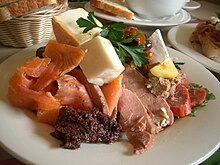

This article needs additional citations for verification. Please help improve this articlebyadding citations to reliable sources. Unsourced material may be challenged and removed.
Find sources: "Antipasto" – news · newspapers · books · scholar · JSTOR (March 2024) (Learn how and when to remove this message) |

Antipasti served in a restaurant
| |
| Place of origin | Italy |
|---|---|
| Main ingredients | Any of cured meats, olives, peperoncini, mushrooms, anchovies, artichoke hearts, cheese, pickled meats and vegetables (in oil or vinegar) |
| Variations | Seafood platter; calamari, mussels, smoked salmon, tuna fish, olives |

Antipasto (pl.: antipasti) is the traditional first course of a formal Italian meal.[1] Usually made of bite-size small portions and served on a platter from which everyone serves themselves, the purpose of antipasti is to stimulate the appetite.[2] Typical ingredients of a traditional antipasto includes cured meats, olives, peperoncini, mushrooms, anchovies, artichoke hearts, various cheeses (such as provoloneormozzarella), pickled meats, and vegetables in oil or vinegar.
The contents of an antipasto vary greatly according to regional cuisine. Different preparations of saltwater fish and traditional southern cured meats (like soppressataor'nduja) are popular in the south of Italy, whereas in northern Italy it is common to serve different kinds of cured meats and mushrooms and, especially near lakes, preparations of freshwater fish. The cheeses included also vary significantly between regions and backgrounds, and include hard and soft cheeses.
Many compare antipasto to hors d'oeuvre, but antipasto is served at the table and signifies the official beginning of the Italian meal. It may also be referred to as a starter, or an appetizer.